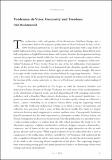Files in this item
Vredeman de Vries: geometry and freedom
Item metadata
| dc.contributor.author | Recktenwald, Olaf | |
| dc.date.accessioned | 2015-08-28T15:22:01Z | |
| dc.date.available | 2015-08-28T15:22:01Z | |
| dc.date.issued | 2014-07-08 | |
| dc.identifier.citation | Recktenwald, O. (2014). Vredeman de Vries: geometry and freedom. North Street Review: Arts and Visual Culture, 17, pp. 75-84. | en_US |
| dc.identifier.issn | 2053-2024 | en_US |
| dc.identifier.uri | http://ojs.st-andrews.ac.uk/index.php/nsr/article/view/748 | en_US |
| dc.identifier.uri | https://hdl.handle.net/10023/7355 | |
| dc.description.abstract | As a result of his highly imaginative perspectival illustrations, late sixteenth-century Dutch architect Hans Vredeman de Vries remained at the pivot point of transferring perspectival developments from Italy to a northern European setting. He brought about a revolution in the genre of the architectural city-view, stood as a giant of that artistic category, and initiated a widespread architectural following that could be felt in buildings from every province of his home country to as far away as regional towns in Peru. This essay introduces the use of geometry in Vredeman’s illustrations from his 1604 treatise Perspective and gives an account of the meanings behind vantage points, picture planes, and the viewing subject in those representations. A commentary on the notion of repetition in perspectival vistas and an explanation of the significance surrounding the placement of the centric point in his engravings is also dealt with. The centric points of Vredeman’s plates are seldom placed on a blank architectural surface. Instead, we encounter deliberate openings that allow us to travel beyond the pictorial plane and that remind us of the artificial nature of the environment being shown. Someone might theoretically be looking back at us, configuring the world before us, and thereby reinforcing the arbitrariness of our point of view. Overall, this paper aims to look anew at the symbolic significance of the perspective engravings of Vredeman de Vries. The writing ends with a summary on what it might mean to transcend a perspective. | en_US |
| dc.language.iso | en | en_US |
| dc.publisher | School of Art History, University of St Andrews | en_US |
| dc.relation.ispartof | North Street Review: Arts and Visual Culture | en_US |
| dc.rights | Copyright (c) The author(s). This is an open access article published in North Street Review. This work is licensed under a Creative Commons Attribution-NonCommercial 4.0 Licence (http://creativecommons.org/licenses/by-nc/4.0//) | en_US |
| dc.rights.uri | http://creativecommons.org/licenses/by-nc/4.0// | |
| dc.subject | Vredeman de Vries | en_US |
| dc.subject | Perspective | en_US |
| dc.subject | Perspective | en_US |
| dc.subject | Engraving | en_US |
| dc.subject | Transcendence | en_US |
| dc.subject.lcsh | Art--History | en_US |
| dc.title | Vredeman de Vries: geometry and freedom | en_US |
| dc.type | Journal article | en_US |
| dc.description.version | https://doi.org/Publisher PDF | en_US |
| dc.publicationstatus | Published | en_US |
| dc.status | Peer reviewed | en_US |
This item appears in the following Collection(s)
Except where otherwise noted within the work, this item's licence for re-use is described as Copyright (c) The author(s). This is an open access article published in North Street Review. This work is licensed under a Creative Commons Attribution-NonCommercial 4.0 Licence (http://creativecommons.org/licenses/by-nc/4.0//)
Items in the St Andrews Research Repository are protected by copyright, with all rights reserved, unless otherwise indicated.


